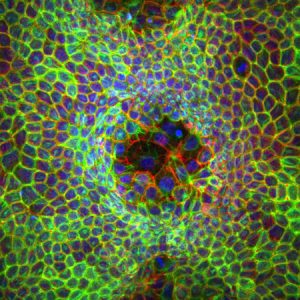
One of the most enviable features of superheroes is their ability to stretch their bodies beyond imaginable limits. In a study published in Nature, scientists have discovered that our cells can do just that.
With every beat of the heart and every breath into the lungs, cells in our body are routinely subjected to extreme stretching. This stretching is even more pronounced when cells shape our organs at the embryo stage, and when they invade tissues through narrow pores during cancer metastasis – but how cells undergo such large deformations without breaking has remained a mystery until now.
This week, researchers at IBEC and the UPC report a new physical property of cells – which they’re calling active superelasticity – that may explain the unusual ability of cells to undergo extreme deformations.
The team, led by Marino Arroyo and Xavier Trepat (centre and right), developed a new approach to subject epithelial tissues – the thin cellular layers that cover internal and external surfaces of the body – to very large deformations, up to four times their original size. These cellular layers are fundamental to life, as they protect the body from radiation, pollutants and pathogens. They’re also responsible for gas exchange in the lungs, absorption of nutrients in the gut, and excretion of urine in the kidneys.
Read more on the IBEC website.
![]()



